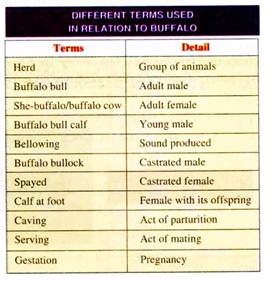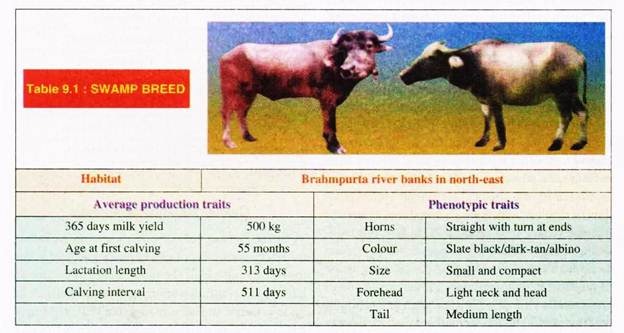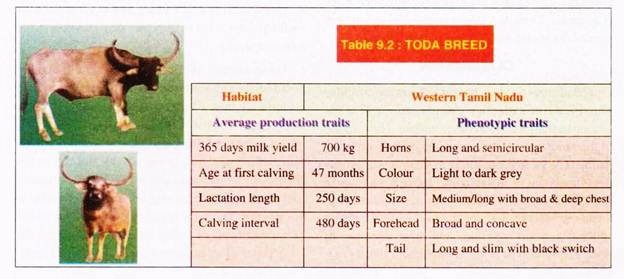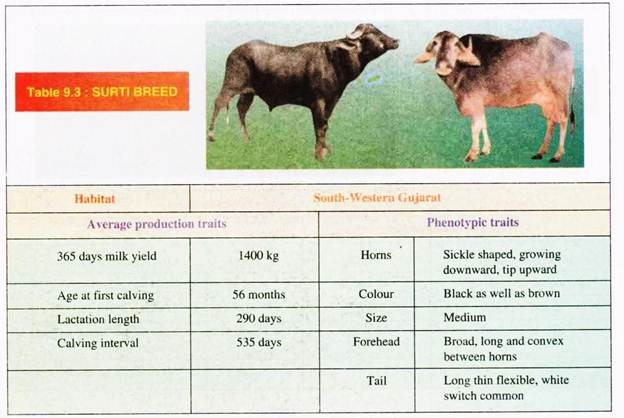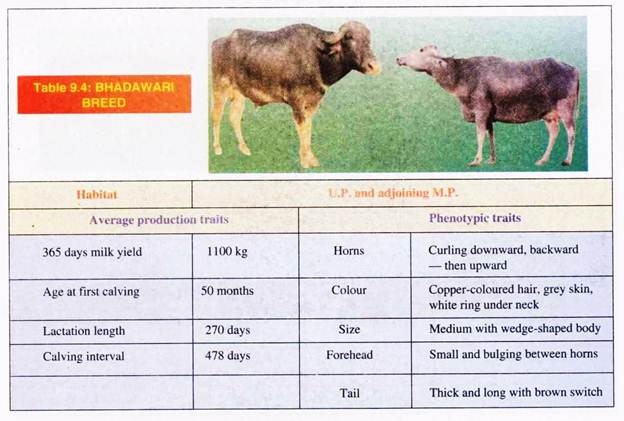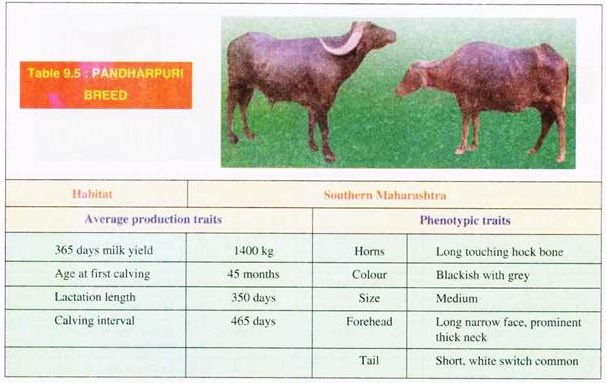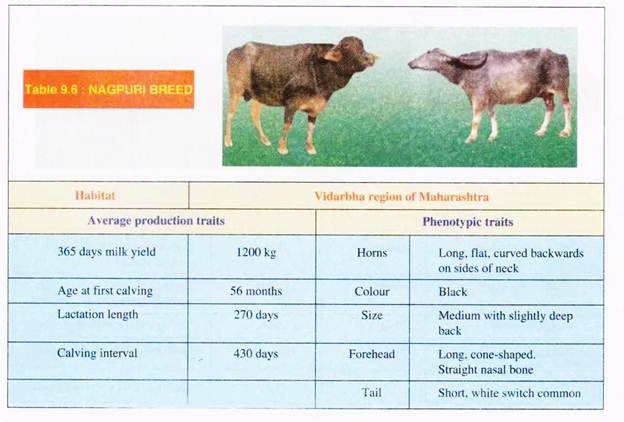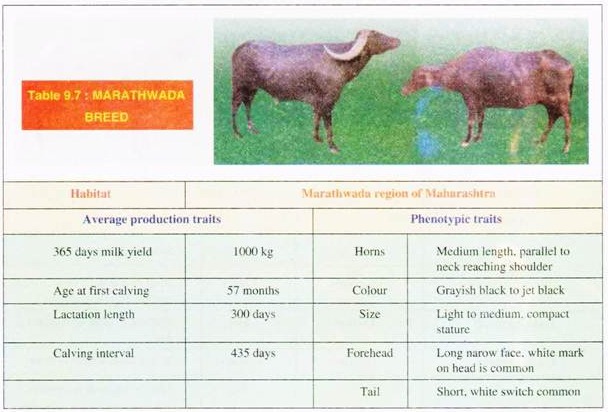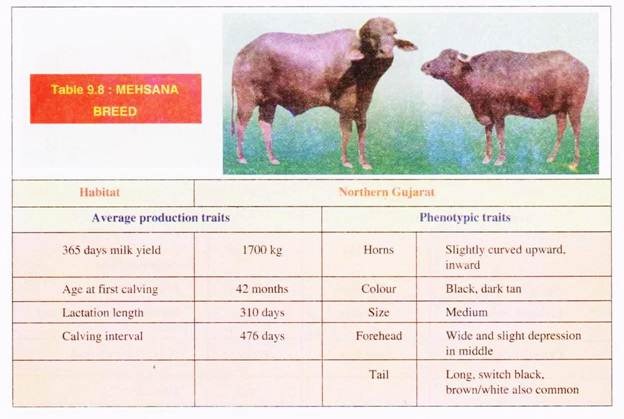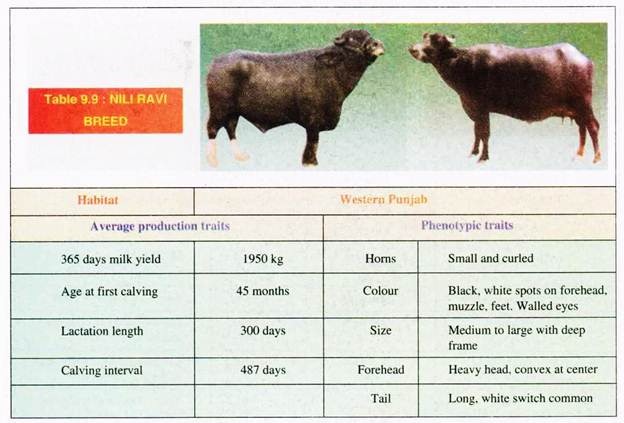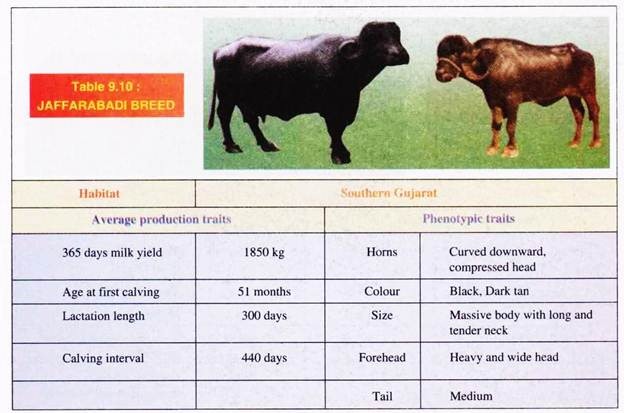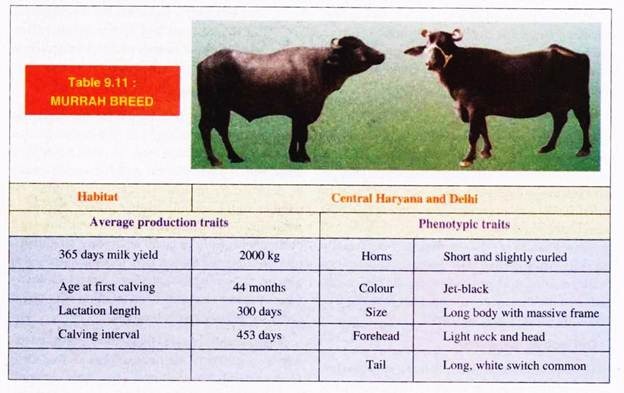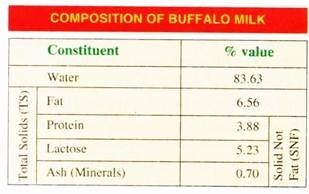In this article we will discuss about Buffalo:- 1. Introduction to Buffalo 2. Classification of Buffalo 3. Characteristics 4. Puberty 5. Husbandry 6. Breeding 7. Breeds 8. Artificial Insemination (Al) 9. Nutrition 10. Economic Uses.
Introduction to Buffalo:
The buffalo is a member of Bovine family and its scientific name is Bubalus bubalis. This is descended from the arni or wild Indian buffalo, and is widely dispersed throughout Southern Asia. The world buffalo population is continuously increasing and was estimated to be more than 170 million in 2003 as reported by FAO (2004).
More than 95 per cent of the world buffalo population is found in Asia where they play a leading role in rural livestock production. Over the last decade buffalo farming has widely expanded in Mediterranean areas and in Latin American countries and several herds have also been introduced in Central and Northern Europe.
Buffalo farming is increasing in Italy too, due to the growing market demand for buffalo milk that is utilized exclusively for the production of “mozzarella cheese”.
ADVERTISEMENTS:
Another economic benefit derived from buffalo milk production is that buffalo milk is not restricted by the specific European Union (EU) directive called “milk quotas”, introduced to stop the increase of cow milk production. In fact, this regulation induced some farmers, in areas where Friesian cattle are traditionally reared, to consider the option of breeding milking buffaloes for the production of “mozzarella cheese”.
This led to an expansion of buffalo breeding in the north of Italy which is away from the customary area, that is southern Italy (Campania, Lazio and Puglia regions), where 95 per cent of the Italian buffalo population is reared.
Classification of Buffalo:
The domesticated buffaloes are commonly classified into two main categories, viz.,
(1) The swamp buffalo and
ADVERTISEMENTS:
(2) The river buffalo.
They belong to the same species but have contrastingly different habits. The swamp buffalo is more or less a permanent inhabitant of marshlands, where it wallows in mud, feeds on coarse marsh grass, and is found principally in Malaya, Singapore, Philippines, Thailand, Indonesia, Southern China and other countries in Asia.
The river type is found throughout India, Pakistan, Bangladesh, Nepal and Sri Lanka. These are primarily milch animals.
Characteristics of Buffalo:
Buffaloes are very docile in nature. In India, usually responsibility of care of milking buffalo is left to women and girls. The men usually take care of bullock. The buffalos are long-lived animals. It is quite common to find a reasonable milk yield or a good day’s work still being achieved even at 15 years of age. Buffalos of 18 years and even more may produce calves. Up to 20 years they can be used in different works.
ADVERTISEMENTS:
These animals are less heat resistant than other bovines, though they are mostly found in tropical countries. Access to water or shade is essential for the well-being of buffalos. Milking animals must have liberal amount of drinking water to avoid dehydration, which can take place at any time.
Sudden changes of temperature and especially the effect of cold winds and draughts may be extremely harmful to this species. These are regularly wallowing animals. The river breeds of Indian sub-continent prefer the clear water of streams and pools.
Buffaloes apparently wallow for two main reasons:
(i) To regulate body temperature, and
(ii) To control parasites.
Puberty in Buffalo:
Puberty in buffalo is delayed compared with cattle. The age at puberty is difficult to establish because of difficulties in oestrus detection in this species and most estimations appear to have been extrapolated from the age at first calving.
The River type puberty is earlier than the Swamp type (21 to 24 months). First conception occurs at an average body weight of 250 to 275 kg, which is usually attained at 24 to 36 months of age. This characteristic is important for buffalo culture.
Husbandry of Buffalo:
Buffaloes are traditionally managed in domestic conditions together with the calf. They are hand- milked twice a day. They are fed with different kinds of roughages (barley and wheat straw, cornstalks, sugar cane residuals). In addition, they are given concentrated mixtures (commercially available food). If grazing is available, they graze all day long. They mate naturally. Some villages also practise artificial insemination.
Breeding of Buffalo:
ADVERTISEMENTS:
Artificial breeding process is mainly restricted to insemination only. In spite of expansion in buffalo breeding, there was no improvement in milk and meat production due to slow genetic progress. The productivity increase obtained is due mainly to an improvement in management techniques rather than to genetic selection.
Breeds of Buffalo:
Eleven Indian breeds are listed according to the breed names given in Mason (1996). The breeds are described in details following FAO data in tabular form (Table 9.1 to 9.11).
Artificial Insemination (Al) in Buffalo:
In India AI has been practised in buffaloes for over 30 years but has lagged behind cattle largely because of the difficulty of detecting oestrous. Chilled semen (5°C), diluted in a variety of extenders is still widely used in buffalo AI.
Buffalo semen can be frozen in extenders used for bovine semen. One such extender is a tris-buffer containing 7% glycerol and 20% egg yolk. Extended semen is packed in 0.25 or 0.1 ml French straws to contain 30 million motile spermatozoa per dose.
Straws are exposed to nitrogen vapour at -120°C to -140°C for 7 to 10 minutes before being stored in liquid nitrogen. Semen should be thawed at 37°C to 40°C. The post-thaw progressive motility of buffalo semen varies from 35 to 60%.
Nutrition in Buffalo:
Buffaloes are mostly found in countries where feeds, fodders and pastures are limited and are of poor quality. In spite of this situation, the buffaloes have thrived reasonably well and relatively better than cattle. Energy and protein requirements have been worked out for maintenance and milk production. The energy requirement for maintenance ranges from 97.8 to 188.8 kcal in dry and lactating buffaloes.
i. Reproductive efficiency is the primary factor affecting productivity and is hampered in the female buffalo by a delayed attainment of puberty, seasonality, long post-partum anestrus and subsequent calving interval, and poor oestrus expression.
Regarding the latter, artificial insemination (AI) which is the normal practice in cattle breeding, is limited in buffaloes due to the weakness of oestrus symptoms and variability of oestrus length that makes oestrus detection very difficult.
ii. Studies have been undertaken in order to better understand the reproductive physiology of the buffalo and the factors affecting its behaviour. Considerable attention has been paid to reproductive endocrinology, with the aim of developing models to improve reproductive efficiency, particularly when controlled breeding techniques are utilized.
iii. There is a large variation in age at puberty of buffaloes in different countries. The delay in puberty and the consequent delay in conception is one of the problems that lead to the low reproductive efficiency of the buffalo species, thus lengthening the nonproductive life,
iv. Many factors influence age at puberty, such as breed, season, climate, nutrition and growth. The buffalo management needs, right from birth, to ensure a correct weight increase. In fact, the animals that show a higher daily gain (before the trials) reach puberty in a shorter time.
The age at puberty is affected by the dietary energy level. The heifers fed with a high level diet (5.56 MFU/day), had a daily gain of 562 g as against 465 g of the heifers fed with a low level diet (4.42 MFU/day), that reached puberty 30 days earlier. In fact, heifers bred with a good early management system conceived at a younger age compared with the others (543±16 and 844 ±11 days, respectively).
Stimulating the hormonal changes occurring around puberty may induce sexual maturity in heifers. Trials to induce and synchronize oestrus in buffalo heifers have been undertaken using PRID (Progesterone- Releasing Intravaginal Device) plus PMSG (Pregnant Mare Serum Gonadotrophin) to induce oestrus in non-cycling buffalo heifers.
Economic Uses of Buffalo:
1. Milk and its Quality:
Dairy industry in India is mainly buffalo oriented, which contribute 55% of total milk produced. The largest number of buffalo cows in India and Pakistan, calve (nearly 80%) during the period of July to December. This period becomes surplus with milk for dairymen.
This surplus milk is converted into other products. Indian buffaloes on an average produce 500 kg of milk during lactation. Daily yield of the lactating buffalo in a well-managed farm is as high as 20 kg.
Uses of Buffalo Milk:
(a) Buffalo milk is used for making Mozzarella cheese in Italy.
(b) Buffalo milk produces better yoghurt in body texture, allows easy separation of cream and churn of butter, ghee and gives better quality of desiccated milk (khoa) and also acid coagulated milk (paneer)
(c) It is a better tea/coffee whitener.
(d) Richer curd can be produced from buffalo milk.
2. Work:
Buffaloes are classic work-animal of Asia. Buffaloes are used in conventional agricultural practices. Buffalo as a draft animal, has working capacity of 0.75 H.P. A sturdy buffalo can pull a weight of 0.9 to 1.0 ton.
3. Buffalo Meat (Carabeef):
In Italy, Bulgaria, Czechoslovakia and Egypt buffaloes are raised mainly for meat. Buffalo meat contains white fat as the beta carotene (the precursor of vitamin A):
4. Buffalo Horns:
Processed horns are used to produce buttons, toggles, combs, spoons, forks, knife handles, napkin rings, wall decorations, shoehorns, etc.
5. Buffalo Hide:
The hide of the water buffalo is an important item for both export and local industries. Pakistan is the largest producer of good quality hides and skins.
6. Buffalo Faeces:
Tremendously used as fuel and organic fertilizer by the rural people.
7. Buffalo Hair:
Their hair is thicker than any other bovine and used for production of brush rather than felt.
